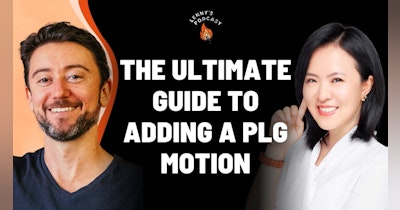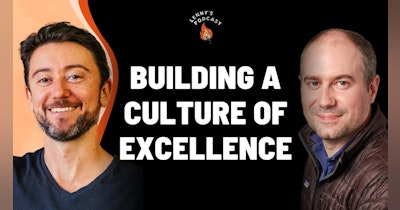Yuhki Yamashita is the Chief Product Officer at Figma. His experience spans Microsoft (Hotmail, Windows), YouTube (iOS app), and Uber, where he developed a lot of his current product philosophy. Toward the end of his time at Uber he switched from the PM to Design team, and that’s when he discovered Figma.
Lenny and Yuhki discuss Figma’s product philosophy, how they build consistently great products, how they hire, what habit Yuhki has found to be the most instrumental in his career success, and what he’s learned by building a product-led-growth business.
You can also see the episode transcript and Yuhki’s references.
What Yuhki learned from being on a design team ▶
- It’s an opportunity for PMs to suspend other constraints temporarily and explore what the absolute best user experience can be.
- Managing designers can be more difficult than managing PMs because designers are really focused on growing their craft, which might not always be the company’s biggest problem. PMs, on the other hand, tend to gravitate toward the areas of highest impact.
Why do PMs need to be great storytellers? ▶
Storytelling is the one habit that has had the most impact on Yuhki’s career success.
- “A story is only as good as the action that it’s capable of driving”: Everyone is constantly distracted, so a good story that sticks is a powerful way to drive a project forward.
- Memification: Certain insights/research that become part of the common conversation. At Uber there were some “memes” that someone like Travis or Dara would just cite in the middle of a meeting, and that’s when you knew you'd really done your job.
- Improving your storytelling: Put yourself in the shoes of a user with no idea of what’s happening and build the story from there.
Why PMs need to know the “why” of their product ▶
- Ideas can come from anywhere. The what and how are shared within the company, but PMs are uniquely responsible for the why.
- When you’re building a big app where everything can’t be specified, you have to enable people to make good decisions autonomously. How? By making sure everyone understands the problem.
- 5 why’s: Figma’s postmortems use the 5-why’s technique to get to root causes, which can be extended to PM.
The importance of community, customer relationships, and feedback ▶
- Figma’s strong community and customer relationships are rooted in their early days when Dylan Field, the CEO, consistently iterated with designers even when nobody believed a design tool in the browser was possible. Even today Dylan is always reading feedback and sharing concerning tweets. It’s a top-down way of encouraging closeness to the customer.
- Have a portfolio of feedback to mitigate blind spots created by vocal minorities. For example, tweets can be thought of as the canary in the coal mine, support tickets skew more toward dissatisfied customers, and sales conversations are more like suggestions.
- Yuhki thinks of product-led growth more as community-led growth. Their sales team often empowers designers within organizations to champion Figma and spread it internally.
Working with Dylan Field ▶
- Dylan relies more on intuition and instinct built off lots of customer conversations. Part of Yuhki’s job is to “build out the logic tree” to see how Dylan gets to his intuition.
- Dylan cares very deeply about any given user and how they feel about Figma, not assuming he already knows the biggest problems and that any particular individual’s experience doesn’t matter.
Building complex features like Figma’s branching and merging ▶
- Branches are exploratory spaces that enable designers to safely try new ideas without making changes to the original file. It was a big investment, but they initially didn’t see the expected results. While performance and unfamiliarity were contributors, a key reason was that they didn’t use the feature much themselves. As they’re increasingly building for larger customers, they have to be more intentional about making sure those features are landing.
The importance of dogfooding and personal accountability ▶
- Your entire company should be using your product, because dogfooding is a powerful way to improve quality quickly. Figma got creative and moved from a memo culture to a deck culture to enable people to use the product more. Uber engineers were more motivated to fix a bug they’d personally encountered.
- One of the most powerful things for a startup is the bottom-up energy. He tries not get in the way of that because it’s a very effective way to improve product quality compared with a top-down approach. Also, an engineer’s estimates for things they want to do are almost always much lower than those that are driven top-down.
OKRs at Figma ▶
3 common failure modes of OKRs:
- The OKR is something you can technically measure and move, but it’s difficult to map it to a high-level goal.
- The OKR is a high-level goal but it’s not actionable because it’s too far from what you’re doing day-to-day.
- The OKR doesn’t map to what a team actually cares about or is trying to do. Even if you understand what a team is doing, you might not understand if they’re actually committed to moving their OKRs.
Basic philosophy around OKRs:
- Legibility: make sure it’s not some weird obscure metric.
- Actionability.
- Authenticity: does it depict what you’re actually doing on a day-to-day basis?
What Yuhki looks for in PMs ▶
2 things stand out:
- Storytelling: For example, “Describe a time when you were part of a controversial product decision” shows if the candidate can set up the problem, explain why it’s important, and take on different perspectives. Another favorite is to talk about a big problem they worked on and see if you walk away feeling compelled to work on that problem.
- High-bandwidth UX conversations: Exploring and evaluating solutions quickly. Uber’s Jack Holden would ask PMs to “fast-forward to the future” and imagine being in a scenario they were trying to assess and see if things played out the way they expected. Imagining outcomes can be a big efficiency driver, and a lot of PM is about these shortcuts.
Advice for founders ▶
- Your product has to have an irrational/emotional response. It starts internally, but eventually users should be shouting about it from the rooftops.
- Equip your users not just with your product but with your philosophy. Figma’s philosophy of showing everyone what you’re working on was controversial and revolutionary, so designers weren’t just championing for a tool but a new way of working.
Future possibilities with Adobe ▶
- Yuhki is excited about making end-to-end workflows using both products more seamless, as well as enabling new experiences with the combined strengths of Figma’s real-time multiplayer collaborative platform and Adobe’s vast suite of creative tools. Superpowers with the combined and the end-to-end process can be made more seamless.
- What won’t change is the proximity to their community, which is part of the magic that makes Figma work.
Closing thoughts ▶
It’s easy to listen to podcasts and think these people have everything figured out. The reality is that all the products and processes around you are always works in progress.
Lightning round
- Books: Switch (organizational change), The Story of the Stone
- Podcast: Serial and Lenny
- Movie or TV show: The Good Nurse
- SaaS products: FigJam, Slack, Asana, Notion, Dropbox Paper, Coda
- FigJam plugin: Alignment Scale
This is a human edited summary of the podcast episode with Yuhki, by Adhiraj Somani (@adhiraj38). To listen to the full episode, go here.








